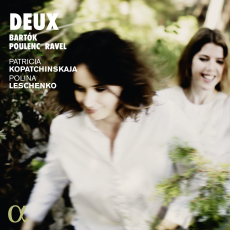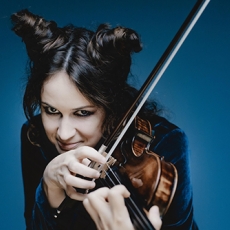Patricia Kopatchinskaja - Deux - BBC Music Magazine
The temptation for the reviewer, when faced with playing of such consummate ease combined with involvement and attention to detail, is to go off the deep end into a sea of purple prose. Simply, this is one of the finest, most musically sensitive recordings to have come my way for some time, and the neat title ‘Deux’ exactly encapsulates the partnership on display. The way that both violinist Patricia Kopatchinskaja and pianist Polina Leschenko attack the Poulenc Violin Sonata (1943), exposing its violently tragic character from the outset, draws you in immediately. The players spin on a dime in the sudden changes of mood, encompassing a bitter sense of humour – with the opening phrase of Tea for Two used in ways that its composer could never have dreamed of – and lyricism coloured with despair. Poulenc himself didn’t think much of the Violin Sonata (his sympathies never really lay with solo string instruments) and he had to have his arm twisted by the French violinist Ginette Neveu to write it at all, but even he might have been convinced by this special performance. Technically, both players are a marvel: Leschenko has her own teasingly virtuosic solo moment in the arrangement by Dohnányi of the Waltz from Delibes’s Coppélia , rivalling Dohnányi’s own 1929 recorded version, and with a range of touch and weight superlatively caught by the recording. Alpha Classics’s sound is equally good at capturing both Kopatchinskaja’s range and depth, and the balance achieved by the performers, not only in ensemble, dynamics and tone, but in the way they respond to the music with unity of purpose in rubato. Even at speed, each note in streams of semiquavers manages to have an individual character and meaning. Beauty of playing doesn’t preclude harshness of sound where it’s needed: the toughness – and sometimes roughness – of the Bartók Second Violin Sonata comes across with as much conviction as delicate passages of harmonics, or places where Kopatchinskaja’s bow barely seems to touch the string. Straining to hear brings its own sense of exhilaration. The transmogrified Hungarian folk music which lies behind Bartók’s music, especially in the second movement Allegretto, is never over-emphasised, but still has a strong presence, especially when it comes to the projection of the rhythmic profile. Like the Bartók, Ravel’s Tzigane (1924) was written for the Hungarian violinist Jelly d’aranyi, incidentally great-niece of the violinist, Joseph Joachim, who advised Brahms on his Violin Concerto. D’aranyi had also tried to get a sonata out of Poulenc, but had failed. Tzigane used to be dismissed as a mere display piece, but I defy anyone not to be bowled over by the sheer variety and depth of playing, especially in the long opening cadenza, where the change of tone and colour in the first note alone is enough to open up worlds, and portamento and vibrato are daring and passionate throughout the performance.


